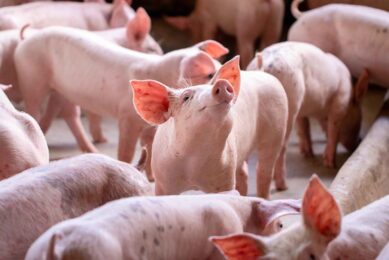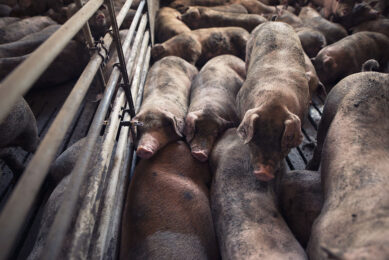PRRS – The disease which keeps bugging us
It certainly does! I’ve just read an excellent review under the above title by Jeff Zimmerman of Iowa State University given to the London (Ontario) Swine Conference 2008. In common with so many of the erudite papers on the disease during the past 5 years, it covers epidemiology (veterinary-speak for what can cause disease) excellently.
It certainly does! I’ve just read an excellent review under the above title by Jeff Zimmerman of Iowa State University given to the London (Ontario) Swine Conference 2008. In common with so many of the erudite papers on the disease during the past 5 years, it covers epidemiology (veterinary-speak for what can cause disease) excellently.
But the paper does not mention management, which from several years of travelling round the world seeing what farmers do and don’t do in one area of preventing viral disease – their strategic management. I feel this area has not changed sufficiently to keep ahead of the way these ‘new’ viruses like PRRS have themselves changed to survive all that we have so far thrown at them.
So why is a management man like myself dabbling in the veterinary field?
Precisely because I suspect one of the underlying causes of PRRS still being so persistent is that the breeder-producer is too hasty in getting his replacement females bred, and much of this involves management strategy.
To combat these modern viruses, I suggest that compared to what we are doing now we need to allow new female intakes to the herd a much longer time to build up a strong natural immune barrier and to involve an outside herd veterinarian more closely and often during the process.
Pre-selection at 60-70 kg, final selection at 100kg, then a slow, steady growth (550g/day, 600 at most) to service at 135kg. This gives time for a 5 week induction period (though I suspect if PRRS is about in the area, 7 weeks is better). This period is split into two – a two-week ‘challenge’ period under the supervision of an experienced pig veterinarian who is in tune with the herds’ disease profile and those of the herds in the district. He can advise what challenges (fence-line contact – with whom and for how long, vaccination, feedback, etc.) are advisable and which may need changing periodically, rather than the same old regime I see year-on-year.
Next, at least a 3 week period of complete rest and quiet away from such things, meaning a ‘challenge period’ and a quite different ‘reinforcement period’ both giving enough time for natural immunity to get established.
Of course such a calm, steady and longer induction period compared to what most breeders do now does cost considerably more, but not as much as PRRS seems to be costing. Zimmerman quotes $560 million/year in the US and that is for just one virus disease.
I know several clients and acquaintances that have taken a deep breath and have adopted this calmer, two-stage approach. Their longer SPL (Sow Productive Life) of two more litters seems to have paid for some, or even much of it, in reduced replacement-capital needs and easier cashflow. Alone, quite apart from a reduction the 45% foregone in daily gain and feed efficiency, 43% mortality and 12% reproductive losses comprises the $560 million Zimmerman describes in the USA last year. They grumble of course, who doesn’t, but they don’t seem unduly troubled by viral disease.
I just wonder if our excellent veterinary academics are paying sufficient attention to outdated induction management being an underlying reason why “PRRS keeps bugging usâ€.
But the paper does not mention management, which from several years of travelling round the world seeing what farmers do and don’t do in one area of preventing viral disease – their strategic management. I feel this area has not changed sufficiently to keep ahead of the way these ‘new’ viruses like PRRS have themselves changed to survive all that we have so far thrown at them.
So why is a management man like myself dabbling in the veterinary field?
Precisely because I suspect one of the underlying causes of PRRS still being so persistent is that the breeder-producer is too hasty in getting his replacement females bred, and much of this involves management strategy.
To combat these modern viruses, I suggest that compared to what we are doing now we need to allow new female intakes to the herd a much longer time to build up a strong natural immune barrier and to involve an outside herd veterinarian more closely and often during the process.
Pre-selection at 60-70 kg, final selection at 100kg, then a slow, steady growth (550g/day, 600 at most) to service at 135kg. This gives time for a 5 week induction period (though I suspect if PRRS is about in the area, 7 weeks is better). This period is split into two – a two-week ‘challenge’ period under the supervision of an experienced pig veterinarian who is in tune with the herds’ disease profile and those of the herds in the district. He can advise what challenges (fence-line contact – with whom and for how long, vaccination, feedback, etc.) are advisable and which may need changing periodically, rather than the same old regime I see year-on-year.
Next, at least a 3 week period of complete rest and quiet away from such things, meaning a ‘challenge period’ and a quite different ‘reinforcement period’ both giving enough time for natural immunity to get established.
Of course such a calm, steady and longer induction period compared to what most breeders do now does cost considerably more, but not as much as PRRS seems to be costing. Zimmerman quotes $560 million/year in the US and that is for just one virus disease.
I know several clients and acquaintances that have taken a deep breath and have adopted this calmer, two-stage approach. Their longer SPL (Sow Productive Life) of two more litters seems to have paid for some, or even much of it, in reduced replacement-capital needs and easier cashflow. Alone, quite apart from a reduction the 45% foregone in daily gain and feed efficiency, 43% mortality and 12% reproductive losses comprises the $560 million Zimmerman describes in the USA last year. They grumble of course, who doesn’t, but they don’t seem unduly troubled by viral disease.
I just wonder if our excellent veterinary academics are paying sufficient attention to outdated induction management being an underlying reason why “PRRS keeps bugging usâ€.











